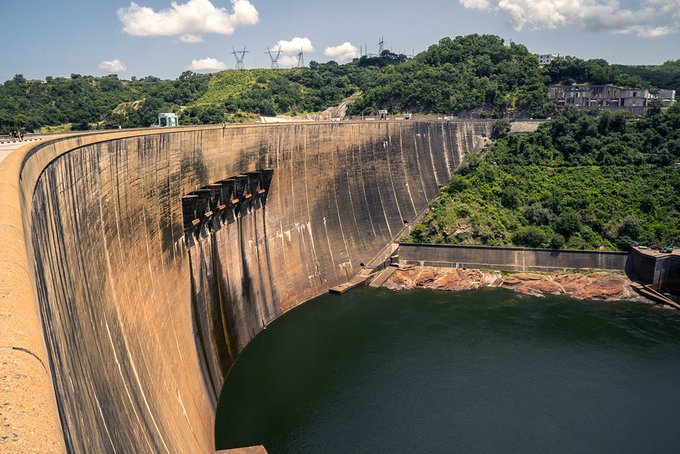
Zimbabwe and Zambia explore floating solar systems at Kariba Dam! Zimbabwe and Zambia are exploring the installation of floating solar power systems at the Kariba Dam as an innovative solution to counteract the declining hydroelectric power generation at the facility.
With the Zambezi River Authority (ZRA) leading the initiative, the feasibility study marks a key step toward introducing alternative power sources at Kariba.
This project, supported by the African Development Bank (AfDB), aims to tackle the challenges brought on by recurring droughts that have significantly reduced the dam’s hydroelectric output.

Addressing Power Shortages Amid Climate Challenges
The Kariba Dam, a critical power generation asset for both Zimbabwe and Zambia, has faced significant production setbacks due to ongoing droughts attributed to climate change. These droughts have led to consistently low water levels in Lake Kariba, affecting the dam’s capacity to meet electricity demands. Currently, Kariba Dam’s installed hydroelectric capacity is 1,050 megawatts (MW), but the facility has recently struggled to generate more than 184 MW, well below its potential.
This shortfall has compounded the energy crisis in Zimbabwe, with citizens and industries experiencing frequent power outages. The recent feasibility study announcement highlights a shift toward more sustainable, climate-resilient energy solutions as both countries aim to stabilize and diversify their power generation portfolios.
Feasibility Study for Floating Solar Power
Last week, Zimbabwe’s Energy and Power Development Minister Edgar Moyo briefed the National Assembly on the feasibility study, emphasizing the potential benefits of floating solar systems. The study, financed by the AfDB, is set to determine whether floating solar technology can be effectively deployed on Lake Kariba.
“There is also a programme that we are working on through ZRA and as council of ministers, a bi-national body bringing together Zambia and Zimbabwe,” said Minister Moyo. “We have commissioned a study which is being financed by AfDB to look at the viability of floating solar systems on Lake Kariba.”

Minister Moyo expressed optimism about the project’s timeline, projecting that the study would conclude by the first quarter of 2025. Following this, construction of the floating solar system could commence if the study deems it feasible. Additionally, the minister mentioned that other related programs on floating solar installations at Kariba are scheduled to begin early next year.
Advantages of Floating Solar Technology
Floating solar systems are a relatively new but rapidly expanding technology that offers several unique advantages, especially for regions facing land scarcity or environmental constraints. Installed on floating platforms, these solar modules generate clean electricity while conserving land and preserving ecosystems. Furthermore, the proximity of the solar arrays to water bodies enhances their efficiency, as the water helps cool the solar cells, improving their performance in hot weather.
For Zimbabwe and Zambia, this technology presents a strategic opportunity to increase power generation capacity without requiring significant new land allocations or extensive modifications to existing infrastructure. The floating systems are also likely to produce higher yields due to the cooling effect of the water, making them a suitable and sustainable solution for countries struggling with reduced hydroelectric power.
Seeking Energy Stability in a Resource-Challenged Landscape
Zimbabwe’s electricity challenges are especially pronounced at its major power stations: Kariba Dam and Hwange Thermal Power Station. While Kariba’s power generation has been hampered by low water levels, Hwange, a coal-powered facility, has faced its own set of operational issues. The declining output at these critical facilities has led to increased load-shedding, causing disruptions to households and businesses alike.
This latest initiative demonstrates Zimbabwe and Zambia’s proactive approach to enhancing energy stability through sustainable methods. By adding floating solar capacity at Lake Kariba, the two countries can mitigate their reliance on hydroelectric power, which has become increasingly vulnerable to changing weather patterns.
Timeline and Next Steps
The AfDB-funded feasibility study is expected to be completed in early 2025. Should the study show that the floating solar project is viable, construction may begin shortly thereafter, offering a new source of reliable electricity that can help alleviate some of the current energy deficits.
In the meantime, Zimbabwe and Zambia remain focused on their broader renewable energy goals. The introduction of floating solar systems represents just one part of an emerging portfolio of renewable energy projects, with both countries seeking to diversify their energy resources and adapt to the ongoing impacts of climate change.
A Promising Future for Renewable Energy in Southern Africa
The feasibility study for floating solar systems at Kariba Dam marks a pivotal moment in Southern Africa’s renewable energy journey. With Zimbabwe and Zambia spearheading this innovative project, both countries are positioning themselves as leaders in climate-adaptive energy solutions. The anticipated success of the Kariba floating solar initiative could set a precedent for other African nations facing similar energy and climate challenges, signaling a transformative shift toward a greener and more resilient future for the region.











